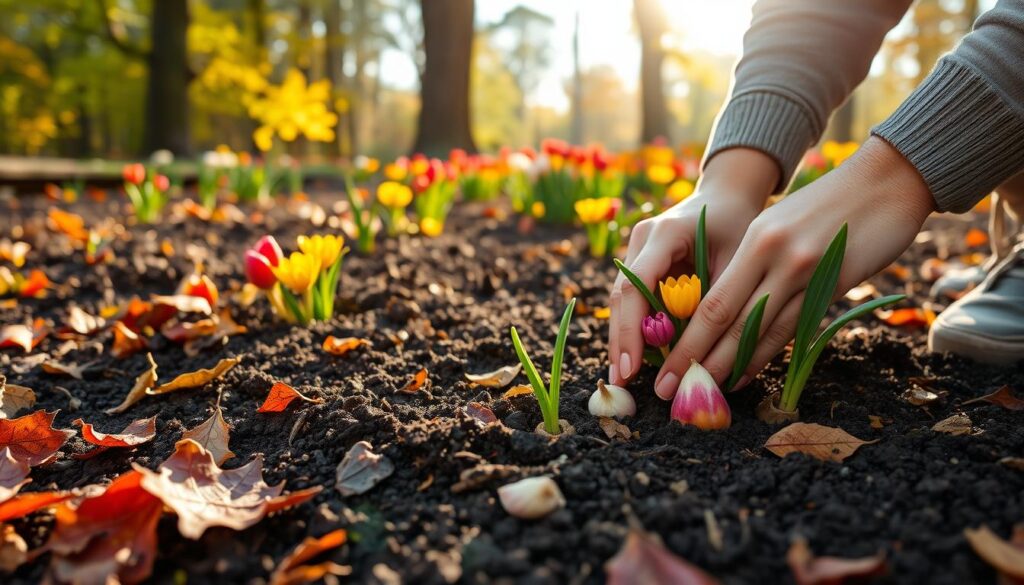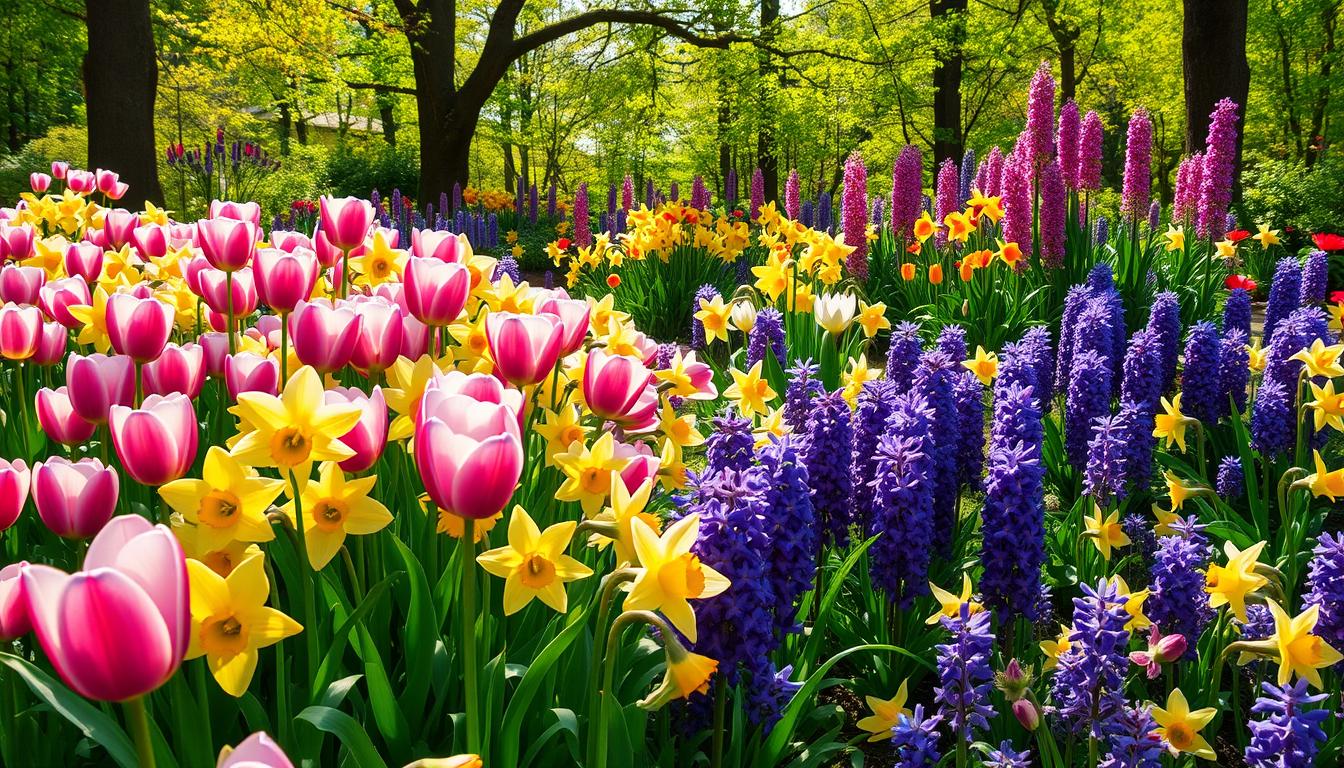Planting fall bulbs is a tradition among gardeners. It ensures a vibrant and colorful spring garden. By planting bulbs in the fall, you prepare for a stunning display of blooms in spring.
Bulbs store energy and nutrients during one growing season. Then, they burst forth with colorful flowers in the next. Many bulbs need cold to break dormancy and start growing. Fall planting is perfect for this.
With the right care and choosing different bulb varieties, you can enjoy blooms all spring. This way, you can have a stunning display that lasts through the season.
The Magic of Fall Bulb Planting
As autumn arrives, it’s time to focus on fall bulbs. These hidden gems will bring color to your garden in spring. Planting bulbs now sets the stage for a vibrant display that will amaze everyone.
Why Plant Bulbs in Fall?
Fall is the best time to plant spring-blooming bulbs. They need cold to grow strong. Planting in fall gives them the chill they need to bloom beautifully in spring.
Popular Spring-Blooming Bulbs
For fall bulb planting, choose from tulips, daffodils, hyacinths, alliums, snowdrops, crocuses, grape hyacinths, and fritillarias. Each type blooms at different times, adding color and variety to your garden.
By selecting a variety of bulbs with different bloom periods, you can create a stunning and prolonged display of color in your spring garden.”
Whether you’re new or experienced, fall bulb planting offers endless possibilities. With some planning, your garden will become a vibrant, eye-catching spring wonderland.
Planting Fall Bulbs: Essential Tips
Timing and Preparation
To get a beautiful spring garden, timing and preparation are key. Plant spring-blooming bulbs in the fall when it’s cool. This is when evening temperatures are between 40-50°F and there’s 6 weeks before the first frost.
This chill time helps the bulbs grow strong roots before winter. Before planting, get the soil ready. Remove weeds, loosen the earth, and add compost to improve drainage and nutrients. Mulch on top helps keep weeds away and protects the bulbs.
It’s important to plant bulbs at the right depth and spacing. Bulb planting depths vary, but a good rule is to plant them 2-3 times their height. Space them 4-12 inches apart, depending on the bulb’s size. Some bulbs, like crocus and grape hyacinth, spread over time, so they can be closer together.
When to plant fall bulbs is critical. Cold-hardy bulbs like daffodils and allium should go in late fall. Winter-hardy bulbs like tulips can wait until early winter in warmer areas. Good soil preparation and bulb depth and spacing lead to a beautiful spring display.

“Timing is everything when it comes to planting fall bulbs. Get them in the ground at the right time, and you’ll be rewarded with a stunning spring display.”
Proper Planting Techniques
Planting fall bulbs right is key for a beautiful spring garden. Plant the bulbs 2-3 times deeper than their height. This helps the roots grow strong and keeps the bulbs safe from winter.
It’s also important to space bulbs correctly. This affects how your garden looks and blooms. Make sure to leave enough space for each bulb to grow and flower well.
Plant bulbs with the pointed end up. This is where the flower will grow from. Good planting and soil care lead to a stunning spring garden. You’ll get to enjoy a variety of colorful bulbs all season.
“Proper planting depth and spacing are key to a successful bulb display. It’s amazing how a little attention to detail can yield such an impressive spring show.”
There are many bulb planters to make planting easier. You can find hand-held or motorized bulb planters. These tools help you plant at the right depth and spacing, making your garden look great.

Conclusion
Planting fall bulbs is a rewarding tradition for gardeners. It lets them enjoy a colorful spring display. By choosing the right bulbs and planting them well, you can create a beautiful garden. This will make you and your visitors happy every year.
Choosing the best bulbs and planting them at the right depth is key. Also, watering and layering bulbs for longer blooms is important. Every step helps your garden thrive in the spring.
Start planting fall bulbs to see your garden come alive in the spring. With a bit of planning and care, your garden will be filled with color. This will make your outdoor space even more beautiful.
Planting fall bulbs is a great way to make your garden more beautiful in the future. You can have a garden full of flowers from the first tulips to the last daffodils. There are many types of bulbs to choose from, like low-maintenance or deer-resistant ones. This lets you create a stunning garden for spring.
FAQ
Q: What are the benefits of planting fall bulbs?
A: Planting fall bulbs brings many benefits. They make your spring garden colorful and vibrant. They also help bulbs grow strong roots before winter.
By planting in the fall, you use nature’s cold to wake up bulbs. This helps them grow and bloom beautifully.
Q: What are some popular spring-blooming bulbs to plant in the fall?
A: Some top bulbs for spring include tulips, daffodils, and hyacinths. Alliums, snowdrops, and crocuses are also great choices. Grape hyacinths and fritillarias add to the list.
Q: When is the best time to plant fall bulbs?
A: The best time to plant bulbs is in the fall. Wait until the evenings are between 40-50°F. Plant about 6 weeks before the first frost.
Q: How should I prepare the soil for planting fall bulbs?
A: Start by removing weeds and loosening the soil. Add organic matter or compost for nutrients and better drainage. Mulch on top helps with weed control and winter protection.
Q: What is the proper planting depth and spacing for fall bulbs?
A: Plant bulbs 2-3 times deeper than their height. Make sure to leave enough space for them to grow and bloom well.






